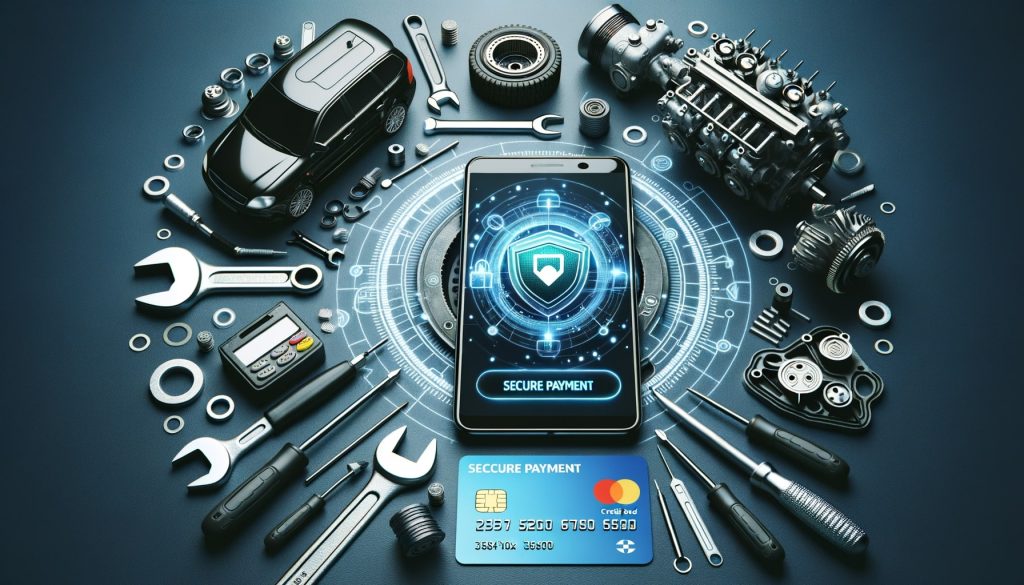With the rise of digital payment methods, mobile payments are becoming a preferred choice for many customers. Auto repair shops, which handle a range of services from routine maintenance to major repairs, must adapt to this trend to stay competitive. However, as mobile payment options grow, so do the security risks associated with handling sensitive financial data. It is crucial for auto repair shops to implement secure mobile payment systems to protect both their businesses and their customers from fraud and data breaches.
This comprehensive guide provides an in-depth look into how auto repair shops can secure mobile payments, ensuring smooth transactions while safeguarding sensitive data. From understanding the common risks to implementing the latest security technologies, this article offers everything an auto repair shop needs to know about securing mobile payments.
What Are Mobile Payments?

Mobile payments allow customers to pay for goods and services using their smartphones, tablets, or wearable devices. Instead of using cash or a physical credit card, customers can simply tap, scan, or authorize a payment through an app. These payments are processed through technologies such as Near Field Communication (NFC), mobile wallets like Apple Pay and Google Pay, or through QR codes and payment apps.
Types of Mobile Payments
There are several types of mobile payment options that auto repair shops might use:
- NFC Payments: Payments made using NFC technology, where a customer taps their phone or card on an NFC-enabled terminal to complete a transaction.
- Mobile Wallets: Payment services like Apple Pay, Google Pay, and Samsung Pay store card information on the customer’s device, allowing them to make secure payments without the need for a physical card.
- Mobile Payment Apps: Customers can use apps like PayPal, Venmo, or Zelle to pay for services directly from their smartphones.
- QR Code Payments: Auto repair shops can generate a QR code that customers scan with their phone to pay directly through their banking app or mobile wallet.
Why Is Securing Mobile Payments Important for Auto Repair Shops?
For auto repair shops, which often deal with high-ticket transactions, securing mobile payments is essential. As mobile payments become more common, cybercriminals are increasingly targeting these transactions, attempting to steal customer data or compromise payment systems.
Key Reasons to Secure Mobile Payments
- Protection Against Fraud: Auto repair shops are often targeted by fraudsters due to the high value of services provided. Without proper security measures, businesses are vulnerable to payment fraud, such as card-not-present (CNP) fraud or account takeovers.
- Maintaining Customer Trust: Customers are becoming more aware of the risks associated with mobile payments. Implementing secure payment processes helps build trust and encourages repeat business.
- PCI Compliance: Auto repair shops must comply with the Payment Card Industry Data Security Standard (PCI DSS) when handling mobile payments. Failure to do so can result in hefty fines and reputational damage.
- Preventing Data Breaches: Mobile payments often involve transmitting sensitive customer data, such as credit card numbers or banking details. Without proper encryption and security protocols, this data can be intercepted by hackers, leading to costly data breaches.
Common Risks Associated with Mobile Payments

While mobile payments offer convenience, they also come with specific security risks. Auto repair shops need to be aware of these risks and take proactive steps to mitigate them.
1. Fraudulent Transactions
One of the most common risks is fraudulent transactions. Criminals may use stolen credit card information, fake mobile payment accounts, or manipulate app-based payments to make unauthorized purchases.
2. Data Interception
Mobile payment data can be intercepted during transmission if it is not properly encrypted. Hackers use techniques such as man-in-the-middle (MITM) attacks to intercept payment data between the customer and the business, allowing them to steal sensitive information.
3. Phishing Attacks
Phishing attacks target both businesses and customers by sending fraudulent messages or emails that trick recipients into providing their payment information. Auto repair shops need to be vigilant about protecting their own and their customers’ data from phishing schemes.
4. Malware and Spyware
Malicious software, such as malware or spyware, can infect mobile devices or payment systems, allowing cybercriminals to gain access to payment data. This is especially concerning for mobile payment apps that store customer payment information.
5. Weak Authentication
If mobile payment systems don’t require strong authentication methods, such as two-factor authentication (2FA) or biometric verification, they can be easily compromised. Criminals can gain access to payment accounts and authorize transactions without the customer’s knowledge.
Best Practices for Securing Mobile Payments in Auto Repair Shops

To mitigate the risks associated with mobile payments, auto repair shops must implement strong security measures. The following best practices will help ensure that mobile payments are processed safely and securely.
1. Use Secure Payment Gateways
A payment gateway is the system that securely transfers payment information from the customer to the payment processor. It is crucial for auto repair shops to use a trusted and secure payment gateway to handle mobile payments.
Features of a Secure Payment Gateway:
- End-to-End Encryption: Ensure that all payment data is encrypted from the point of entry to the payment processor, making it inaccessible to hackers.
- PCI DSS Compliance: Choose a payment gateway that complies with PCI DSS standards, which require strict security protocols for handling credit card data.
- Tokenization: Tokenization replaces sensitive payment information with a unique identifier (token), so the actual data is never transmitted, reducing the risk of data theft.
- Fraud Detection Tools: Secure payment gateways offer built-in fraud detection tools, such as address verification services (AVS) and card verification value (CVV) checks.
2. Enable Multi-Factor Authentication (MFA)
Multi-factor authentication (MFA) requires customers to verify their identity through multiple methods before a payment is authorized. This adds an extra layer of security to mobile payments.
How MFA Works:
- Two-Factor Authentication (2FA): This common form of MFA requires customers to enter their password and a one-time code sent via SMS or email.
- Biometric Authentication: Mobile payment apps often use biometrics, such as fingerprint or facial recognition, to verify the customer’s identity.
- Security Tokens: Some systems use hardware or software-based tokens to generate one-time passwords (OTPs) for transaction verification.
Enabling MFA for mobile payments helps prevent unauthorized transactions, even if a criminal has access to the customer’s payment information.
3. Use EMV Chip and Contactless Payments
EMV chip technology and contactless payments (such as NFC) offer more security than traditional magnetic stripe cards. EMV chips create a unique code for each transaction, making it difficult for fraudsters to clone cards or steal data.
Benefits of EMV and Contactless Payments:
- Dynamic Data: Each transaction generates unique data, so even if the data is intercepted, it cannot be reused by criminals.
- Faster Payments: Contactless payments are quicker than traditional methods, providing a seamless customer experience while maintaining security.
- Reduced Fraud Risk: EMV chip and NFC payments are more secure than traditional methods, as they reduce the risk of data theft or skimming.
4. Implement Mobile Device Management (MDM)
For auto repair shops using mobile devices to process payments, Mobile Device Management (MDM) solutions can help secure these devices. MDM allows businesses to monitor, manage, and secure all mobile devices used for payment processing.
Key Features of MDM:
- Device Encryption: Ensure that all data on the mobile device is encrypted, protecting sensitive information in case the device is lost or stolen.
- Remote Wipe Capability: If a mobile device used for payment processing is lost or stolen, MDM systems can remotely wipe the device to prevent unauthorized access to customer data.
- App Whitelisting: MDM can control which apps are allowed on the device, preventing the installation of malicious software or apps that could compromise security.
5. Educate Employees on Payment Security
Employee training is an essential component of securing mobile payments. Employees should be aware of the potential risks associated with mobile payments and know how to identify suspicious activity.
Key Areas of Employee Training:
- Recognizing Fraud: Teach employees how to recognize signs of payment fraud, such as declined transactions or mismatched customer information.
- Secure Payment Processing: Ensure that employees follow best practices when processing mobile payments, such as verifying customer identity and using secure payment terminals.
- Handling Suspicious Transactions: Establish clear protocols for handling suspicious transactions or payment issues. Employees should know how to escalate these cases to management or your payment processor.
6. Regularly Update Payment Systems and Software
Outdated software and payment systems can leave your business vulnerable to security threats. Auto repair shops should regularly update their payment processing systems, mobile apps, and other software to ensure that they are protected against the latest security risks.
Best Practices for Updating Payment Systems:
- Install Security Patches: Make sure that any security patches or updates released by your payment system provider are installed promptly to fix known vulnerabilities.
- Upgrade Hardware: Periodically evaluate whether your payment terminals and mobile devices need to be upgraded to support the latest security technologies, such as NFC and EMV chips.
- Test Security Systems: Regularly test your payment systems for vulnerabilities or weak points. Penetration testing can help identify security gaps before they are exploited by hackers.
How to Respond to Mobile Payment Security Breaches

Even with the best security measures in place, there’s always a possibility that your auto repair shop could experience a security breach. Knowing how to respond quickly and effectively can minimize the impact of the breach and protect your customers.
1. Identify and Isolate the Breach
The first step in responding to a security breach is identifying the source of the
